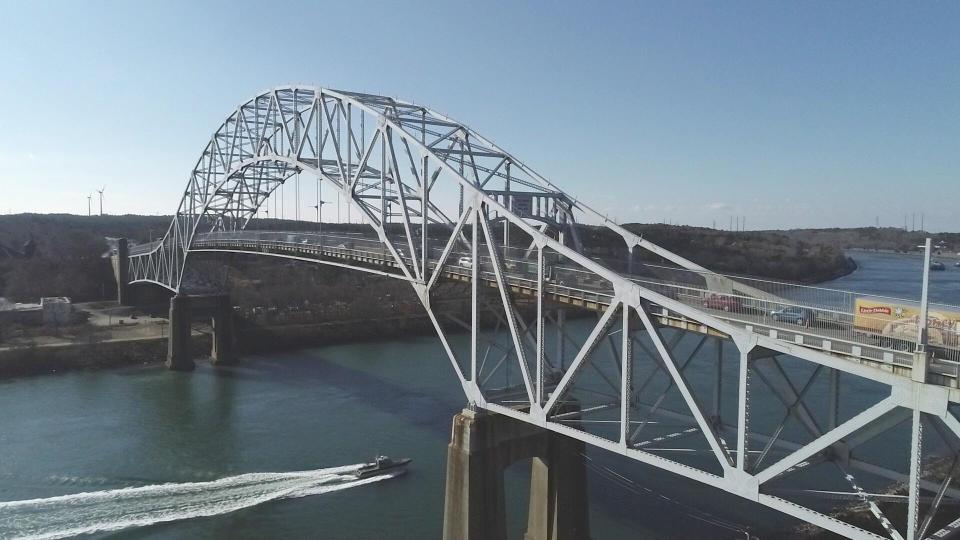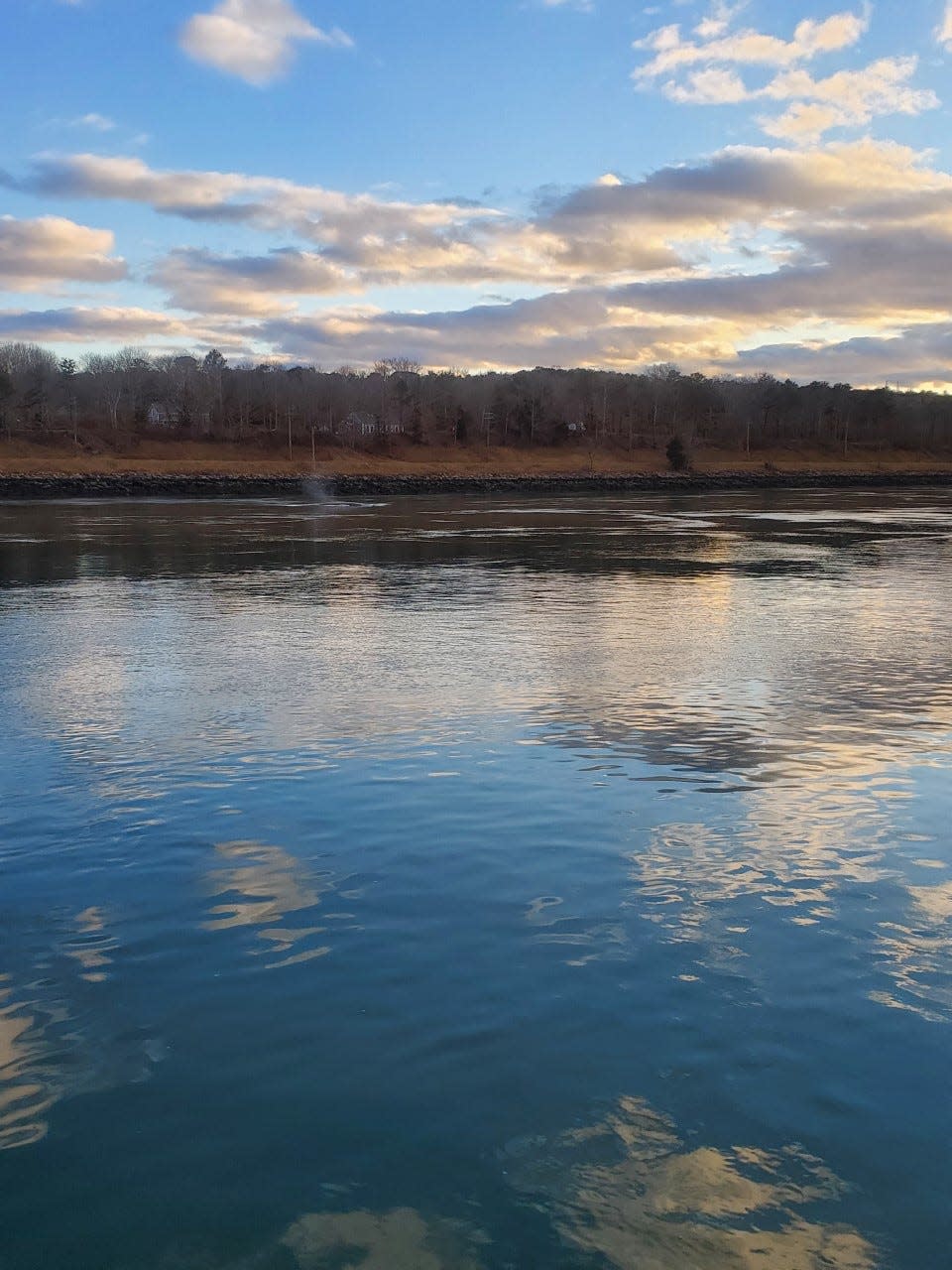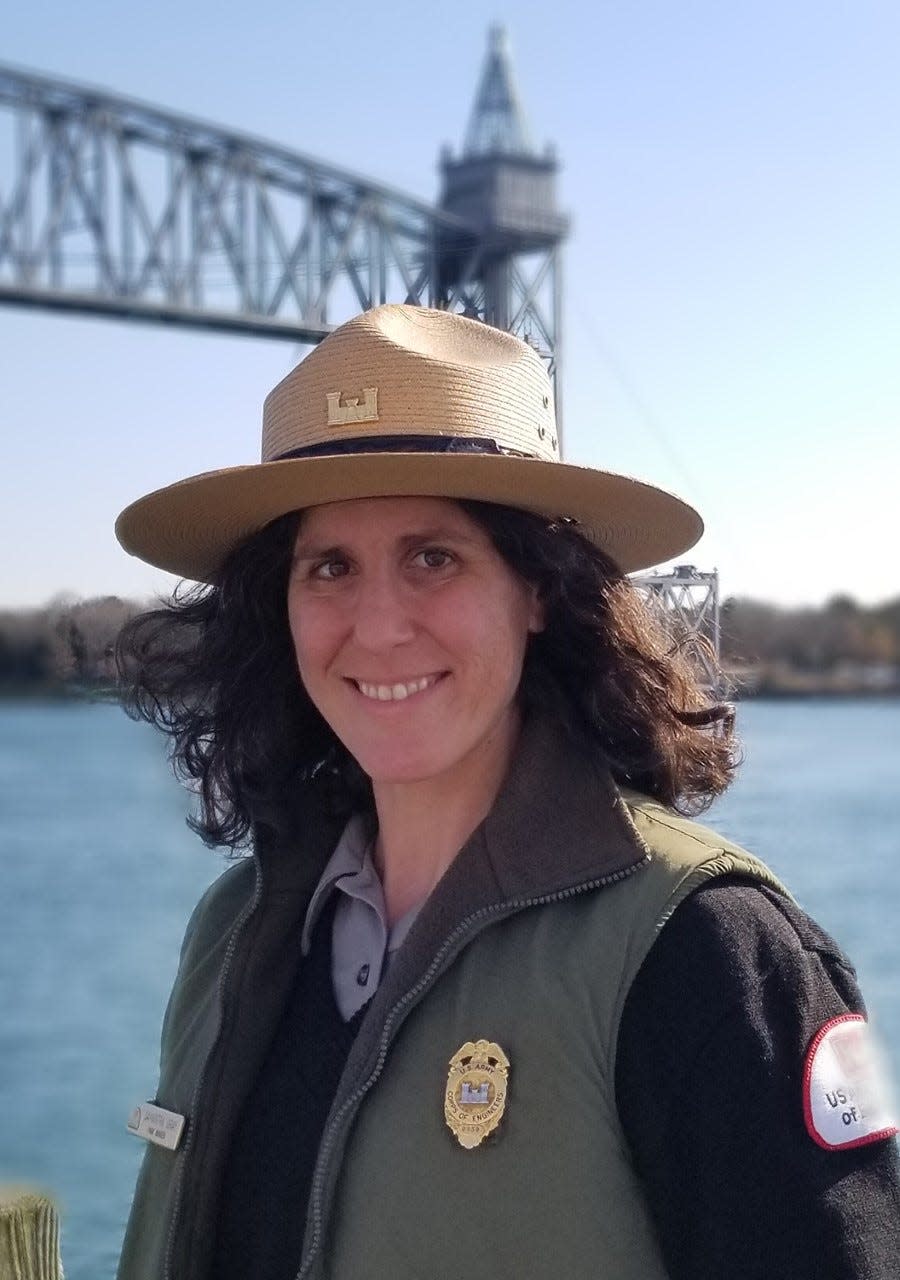Whales that swam into Cape Cod Canal were young. Researchers may know their mothers.
Cape Cod Canal was closed to vessel traffic for a little more than 21 hours over the weekend until two North Atlantic right whales spotted in and near the waterway were safely out of harm's way.
The United States Coast Guard First District office confirmed the canal's reopening around 9:30 a.m. Monday. The canal was closed Sunday for the safety of the whales, members of a critically endangered population that frequents Cape Cod and Massachusetts bays. One whale came in from the Buzzards Bay side, making it nearly the entire 17.4-mile length of the canal before turning back and reentering Buzzards Bay overnight Sunday into Monday. Another was observed near the canal's entrance on the Cape Cod Bay end.
While whales in the canal is not a frequent occurrence, it is standard to close the waterway to vessels when they do enter the canal, or are present very near the east and west openings, until the animals have cleared out.

Vessels that were held at anchorage since Sunday afternoon were transiting the canal as of 11 a.m. Monday. Roughly 15,000 vessels transit the canal each year, according to Gray, and of those about 6,000 vessels are 65 feet or longer.
According to scientists at the Center for Coastal Studies in Provincetown, as well as at the New England Aquarium and NOAA Fisheries, one of the leading causes of severe injury and death among the whales is vessel strikes, along with entanglement in traditional fishing gear.
With only about 340 individuals — plus or minus seven — remaining, according to a report released in the fall by the North Atlantic Right Whale Consortium, the whales are VIP visitors to the region's waters.
Whales are returning:Boaters beware: Warmer waters put right whales in Cape Cod Bay at risk
The marine animals, which typically migrate south for the winter, have been returning to the bays in the past several weeks. On Jan. 19, Massachusetts Division of Marine Fisheries put out an alert after more than two dozen right whales were observed group feeding, urging mariners to use extreme caution when transiting Cape Cod Bay to avoid collisions.

Charles "Stormy" Mayo, director of the right whale ecology program at the Center for Coastal Studies in Provincetown, at the time noted the whales were surface feeding, which he said is unusual behavior at this time of year. The animals were feasting on high surface concentrations of zooplankton.
Park Ranger Samantha Gray, who gave a briefing about the weekend canal closure on Monday morning, said the U.S. Army Corps of Engineers, New England District operates boat patrols, and also cooperates with the Massachusetts Environmental Police and the Center for Coastal Studies as they watch for marine mammal activity.
When were the whales seen in the Cape Cod Canal?
She said the whale on the Buzzards Bay side of the canal was spotted around 8:45 a.m. Sunday in the Hog Island Channel during a routine boat patrol, she said. Then, around 11:30 a.m., the Center for Coastal Studies' aerial team doing a routine survey observed a whale near the entrance of the canal on the Cape Cod Bay side.
Massachusetts Environmental Police and U.S. Coast Guard vessels joined efforts with park rangers in patrolling the canal. The Corps of Engineers' Marine Traffic Control Center made the call to close the canal just before noon on Sunday.
Gray said the whale that was first seen in Hog Island Channel continued past the Bourne Bridge and past the herring run. "It was seen as far east as the fish pier at Scusset Beach, before it made its way back towards Buzzards Bay," she said.
Authorities tracked the whale into the night. The individual was observed around 9 p.m. passing the Massachusetts Maritime Academy and heading back into the Hog Island Channel. Because darkness made it difficult to keep tabs on the whale's movements, the Marine Traffic Control Center decided to keep the canal closed to vessel traffic overnight.
Patrols were out bright and early by 5:30 a.m. Monday morning, Gray said, as vessels seeking transit continued to wait in Buzzards Bay. Patrollers spotted a whale blow at 6:45 a.m. in Buzzards Bay near Hog Island buoy No. 4, but outside the channel. A couple of hours later, the canal was reopened.
"This time of year multiple agencies are constantly vigilant for the presence of North Atlantic right whales," Gray said, noting "whales are in this area for feeding and presence of food. A lot of times they're drawn into the canal if the current brings their food in."

What did the airplane survey team see at the Cape Cod Canal?
Amy James, flight coordinator for the Right Whale Ecology Program at the Center for Coastal Studies, said she was on the routine flight that spotted the other whale on the Cape Cod Bay side of the canal. The whale was near the mouth of the canal, and the team reported their sighting to the canal authorities. A bit later, she said, the team returned and saw the whale was closer to the canal.
"It was feeding just below the surface. It was really targeting a specific patch of food," James said.
The team also detoured to the other side of the canal, not their usual territory, to help with sighting the whale observed on the Buzzards Bay side.
James said both animals are juveniles. The one on the Cape Cod Bay side is tentatively identified as the 2021 calf of a right whale known as Grand Teton (catalog #1145 in the North Atlantic right whale catalog maintained by the New England Aquarium), and the one on the Buzzards Bay side is tentatively identified as the 2022 calf of a whale known as Silt (catalog #1817). The IDs are not certain because young whales' features are still changing, James explained.
It's rare for a whale to swim all the way through the Cape Cod Canal, according to one expert.
Mayo on Monday said it's not unknown for whales to "go well up into the canal" at times. What's more rare is for whales to swim all the way through the canal, which connects Buzzards Bay and Cape Cod Bay and runs through the towns of Bourne and Sandwich — in December 2008, the Cape Cod Times reported, the canal was closed for 2½ hours as a right whale swam east to west through the canal, exiting at Buzzards Bay; before that, the last one known to traverse the canal was in 2001.
"Of course when the happens it throws a bit of wrinkle in canal operations," he said.
Gray said when whales do enter the canal, it's typically from the Cape Cod Bay side, an important feeding ground for the whales in the winter and early spring. It's very unusual for a North Atlantic right whale to enter the canal from the Buzzards Bay end, she said.
When whales do enter the canal, "from our point of view as conservationists and scientists it's something that gives us both trepidations and great curiosity of why would they go into the canal? These animals, the North Atlantic right whales, are odd creatures," Mayo said.
He noted the whales' close relatives in other parts of the world "are known to go into shallow waters and ground themselves."
"Because of that type of behavior they seem comfortable in tight quarters," he said.
He noted that the behavior of the young whale on the Buzzards Bay side of the canal was the most odd.
The Center for Coastal Studies teams have identified 83 right whales in Cape Cod Bay since December, James said.
Gain access to premium Cape Cod Times content by subscribing.
This article originally appeared on Cape Cod Times: Why do whales swim through the Cape Cod Canal? What we know.

